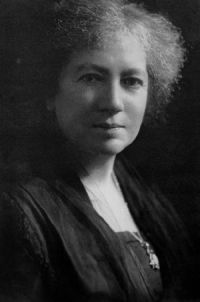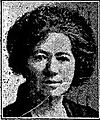Maria Gordon facts for kids
Quick facts for kids
Dame May Ogilvie Gordon
|
|
|---|---|

Dame May Gordon
|
|
| Born |
Maria Matilda Ogilvie
13 April 1864 Monymusk, Aberdeenshire, Scotland
|
| Died | 24 June 1939 (aged 75) Regent's Park, London
|
| Resting place | Allenvale Cemetery, Aberdeen, Scotland |
| Nationality | Scottish |
| Citizenship | British |
| Alma mater | Heriot Watt College, University College, London, University of Munich |
| Spouse(s) |
Dr John Gordon
(m. 1895–1919) |
| Children | 3 |
| Awards | Lyell Medal (1932) DBE (1935) Honorary LLD from University of Edinburgh (1935) |
| Scientific career | |
| Fields | Geology |
| Thesis | (1900) |
Dame Maria Matilda Gordon (born Maria Matilda Ogilvie; April 30, 1864 – June 24, 1939) was a very important Scottish scientist and politician. She was known as May Ogilvie Gordon. She studied rocks and Earth's history (geology) and ancient life forms (palaeontology). She also worked to improve the rights of women and children.
Maria Gordon made history by being the first woman to earn a Doctor of Science degree from the University of London. She was also the first woman to get a PhD from the University of Munich in Germany.
Contents
Early Life and Education
Maria Ogilvie was born in Monymusk, Scotland, in 1864. She was the oldest daughter of Reverend Alexander Ogilvie. Her father was the headmaster of Robert Gordons College. Maria had five brothers and two sisters. Her older brother, Francis Grant Ogilvie, also became a scientist. He directed the London Science Museum.
When she was nine, Maria went to the Merchant Company Edinburgh Ladies' College. She studied there for nine years. She became the top student and head girl. At 18, she started studying piano at the Royal Academy of Music in London.
However, she left music after a year. She decided to study science instead at Heriot-Watt College. She focused on geology, botany (plants), and zoology (animals). She finished her degree in 1890 at University College London.
In 1891, Maria wanted to study more in Germany. She tried to join Berlin University. But women were not allowed to study at universities in Germany at that time. Even with help from important friends, she was refused.
She then went to Munich with a famous geologist, Baron Ferdinand von Richthofen. There, she could do her research. In July 1891, she joined the Richthofens on a trip to the Dolomites mountains.
It was in the Dolomites that Maria started to focus on geology. In 1893, she earned her Doctor of Science degree in Geology from the University of London. She was the first woman ever to receive this degree. In 1900, she and Agnes Kelly became the first women to get a PhD from the University of Munich. Maria earned high marks in geology, palaeontology, and zoology.
Geological Research in the Alps
All of Maria Gordon's geology research happened in the South Tyrol region. This area is part of the Italian Alps, near the border with Austria. These mountains are called the Dolomites. They have tall, dramatic peaks.
People used to think the Dolomites were formed from old coral reefs in an ancient sea. But Maria Gordon had a different idea. She believed the mountains were formed by the Earth's crust pushing, twisting, and folding. She called this idea 'crust-torsion'.
Maria carefully observed and measured the rock structures in the Dolomites. She found that the mountains had gone through two main phases of folding and shaping. Her work helped scientists understand how the Alps were formed.
She wrote over 30 scientific papers about her research in this area. Some of her papers are still considered very important today. One person who wrote about her said she was "probably the most productive woman field geologist" of her time.
Working for Change: Politics and Women's Rights
Maria Gordon was also active in politics. She was a member of the Liberal Party. She strongly supported Women's Rights. In 1922, she was chosen to run for Parliament in the Canterbury area. She later withdrew from that election.
In 1923, she ran again as a Liberal candidate for the Hastings area. She came in second place in that election.
Maria was a strong voice for women. She was a Vice President of the International Council of Women. She was also the Honorary President of the Associated Women's Friendly Society. She led the National Council of Women of Great Britain and Ireland. After World War I, she played a key role in talks about women being represented in the League of Nations. The League of Nations was an organization that aimed to promote peace.
Legacy and Recognition
Maria Gordon's contributions are still remembered today. In 2000, a new fossilized fern was named after her. It is called Gordonopteris Iorigae. This fern was found in the Triassic rocks of the Dolomites.
At the Ludwig Maximilian University of Munich, a room in the library is named in her honor. It is called the Maria-Ogilvie-Gordon-Raum. This room holds the geology department's map collection.
Images for kids
See also
 In Spanish: Maria Gordon para niños
In Spanish: Maria Gordon para niños


